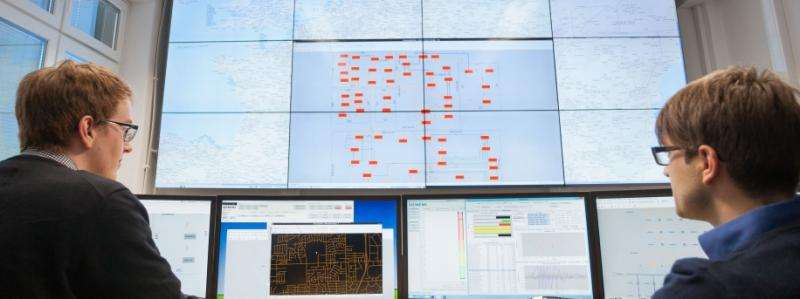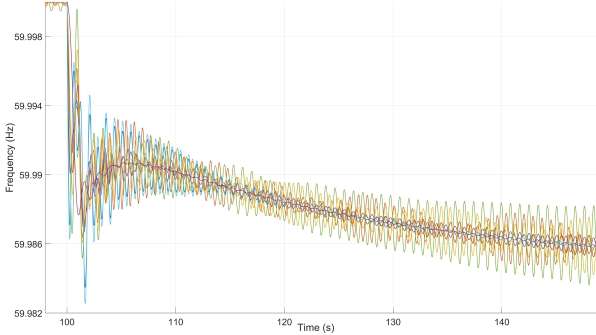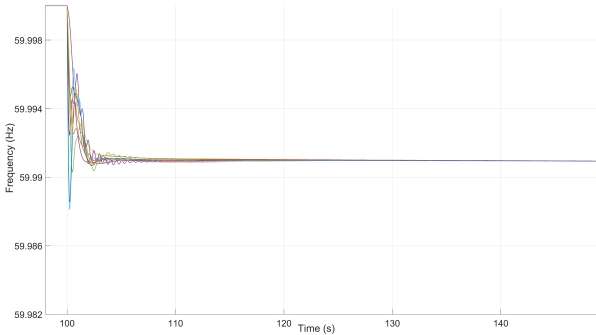World's first dynamic grid control center

The transition to a new energy mix is making the power grid more dynamic. Siemens is coordinating a major research project designed to determine the extent to which existing control center technology can accommodate additional functions, and at which point entirely new structures and architectures will be needed.
Siemens and its partner entities have built the world's first dynamic grid control center. The "DynaGridCenter" project is aimed at determining how control centers will have to function in the future. Here, the focus will be on optimizing the management of energy generated from renewable sources and the associated electricity trading environment. Increasingly, energy no longer flows steadily from power station to consumer, but is subject to fluctuations. These fluctuations must be managed virtually instantaneously in order to prevent potential brownouts or blackouts. Existing control centers lack both the information and the tools for this level of dynamic grid management.
Today's power grids were built to transmit energy across short distances from power stations to consumers. But in the future, grids will have to supply major cities from remote offshore wind farms as well as providing competitively-priced power to electricity traders. At the same time, countless producers are already feeding variable amounts of energy from renewable sources into the grid at all voltage levels. This upsets the balance between power generation and consumption, causing potential overloads and fluctuations.
At the moment, control center operators don't see these fluctuations. They see only how much electricity is being transported and where, and can only identify whether a line is overloaded. They can then switch power stations on or off, essentially altering the gradient in the power grid. This "re-dispatch" process costs up to €1 billion per year in Germany alone – because power station capacity has to be ready to respond to peaks in demand and because of the high costs typically associated with ramping up a power plant's output. All told, it would be better if control centers could steer the grid directly.

Making Fluctuations in the Grid Visible
And that's exactly what the dynamic grid control center is designed to do. Located at the Ilmenau University of Technology, roughly 175 km north of Nuremberg, the control center is connected to a simplified simulation model of the European power grid operated by the University of Magdeburg. The grid model transmits measurement data to the control center, where it's analyzed in real time. The data is based on measurement technology that is already installed in many parts of the grid, but that most control centers are not yet able to make use of. Phasor Measurement Units (PMUs), for instance, measure the extent and phase angle of current and voltage every 10-20 milliseconds. PMUs in the grid are synchronized to enable measurement values from different transformer substations to be directly compared. The ability to make use of this information would make fluctuations in the grid visible.
The DynaGridCenter at the heart of this research project operates predictively. Every 15 minutes, it receives new status data from the grid, and using a simulation model it calculates the changes that will happen in the grid in the next few minutes. It then simulates the effect that different actions would produce. By the time the next update arrives, it will have calculated thousands of scenarios and suggested the most appropriate action to the operator. Based on this prediction, the operator can take action in good time and nip potential fluctuations in the bud. The grid control center also learns from the operator's experience by recording which suggestions are accepted, and includes this detail in its calculations.

HVDC Lines: a Valuable Control Instrument
DynaGridCenter researchers have assigned an important role to high-voltage DC transmission systems. HVDC systems, such as those Siemens has built in China and India, transmit vast amounts of power across long distances. And because they are connected to the grid using the latest power electronics, they can be controlled directly. That's why the grid model in Magdeburg already incorporates planned HVDC lines. The DynaGridCenter uses these to redirect power, for example, and to modulate capacity by means of tailored frequencies that attenuate fluctuations.
Not only is the center being used to illustrate how grid dynamics can be fine tuned. It is also being used to discover just how far existing control center technology can accommodate additional functions, and at which point entirely new structures and architectures will be needed.
The DynaGridCenter project began in October 2015 and will run for three years.
Provided by Siemens





















